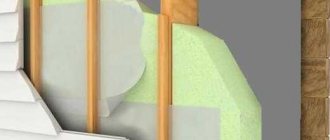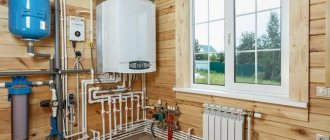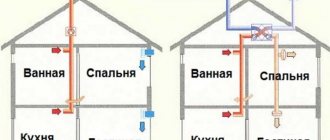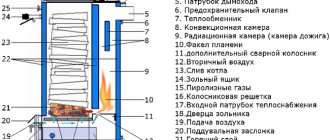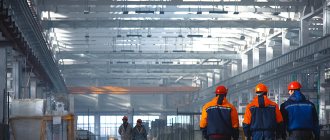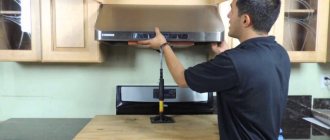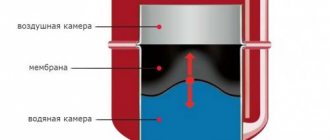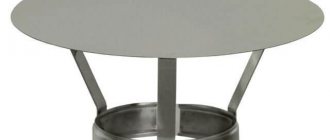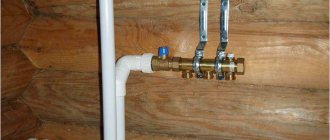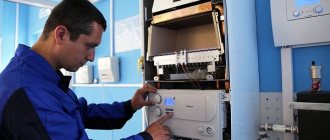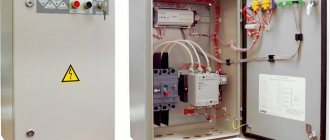.
Air recirculation is the mixing of a certain amount of exhaust air and supply air masses. Thanks to this method, there is a significant reduction in energy wasted on heating purified air masses in cold seasons.
The air recirculation mode helps to significantly reduce energy waste for heating purified air masses in the cold season
Operating principles of recirculation ventilation
The general scheme of operation of a supply and ventilation system with recirculation is as follows: street air is supplied into the room through the supply air, which after some time is drawn into the exhaust system. Some of it is irretrievably thrown out into the street, and some goes into the mixing chamber. There, the air is mixed with the fresh influx, cooling or heating it (depending on the type and settings of the system), then it enters the heater or air conditioner, from which it again enters the room through the ventilation pipes. The main purpose of recirculation is to reduce the load on air treatment systems (heaters, air conditioners, etc.).
To ensure that the air in the room remains fresh and breathable, when using recirculation in the ventilation system, the following conditions must be met:
- The volume of clean air coming from outside must be at least 10% of the capacity of the air handling unit;
- The air entering the room must contain a maximum of 30% of harmful substances from their maximum permissible concentration.
Main aspects of recycling application
The main feature of using the recirculation mode is that no air exchange occurs in the room, since part of the air masses that were removed from the room, after the necessary cleaning measures, returns there again.
Application of the recycling principle is possible only if the following rules are observed:
- the mass of clean supply air masses must be at least 10% of the total amount of air masses supplied to the room;
- air masses penetrating into the room must contain no more than 30% of harmful substances relative to their maximum concentration.
Ventilation with recirculation and heating.
Cold outside air is mixed with warm air taken from the room, heated to the required temperature, and then supplied to the room
- fans are on
- Outdoor and exhaust air valves are open
- the heater is working
- supply and exhaust fans included
- the external, exhaust and recirculation air valves are open, each depending on the set amount of external air
- the heater is working
Navigation
- How does the recirculation flap fail?
- How to check the serviceability of the damper?
- Replacing the damper
- Replacing the damper. Alternative option.
- Damper repair
- Buying a damper
- New modification of the damper
- How can I prevent the recirculation flap from breaking down in the future?
- Stabilizer installation
The recirculation damper is part of the climate control system. It blocks the air intake from the street and ensures recirculation of cabin air through the cabin filter of the ventilation system. The damper consists of a housing-air duct and a moving part driven by an electric drive. The damper is controlled manually using a button on the climate control unit or automatically (if there is an air quality sensor).
Ventilation with recirculation without heating
During the transition period, when the outside air temperature rises and the indoor heating system is operating, the task of the supply ventilation system is reduced only to supplying fresh air. In this case, you can do without additional heating of the air after recirculation.
- fans are on
- The return air valve opens in proportion to the supply air temperature requirements
- The outside air valve closes in proportion to the supply air temperature requirements
- heater doesn't work
- supply and exhaust fans included
- External, exhaust and recirculation air valves are open - depending on the supply air temperature requirements
- heater doesn't work
The use of air recirculation in ventilation systems is allowed only during cold and transitional periods of the year (for air conditioning units at any time of the year). In this case, outside air must be supplied to the room in an amount not less than that specified above.
Preventing valve damage
In order to further minimize the risk of failure of the recirculation damper on Opel Astra cars, it is necessary to artificially reduce the torque of the electric drive, which is responsible for the operation of the climate control element.
To reduce the torque and power of the electric drive, a current stabilizer is connected to the electrical circuit of the device.
Moreover, here there are 2 options for installing the stabilizer.
The first includes a pair of LM317 type microcircuits, 2 resistors and also 2 diodes. Resistors are used with a nominal value of 8.2 ohms. The stabilizer is configured for current parameters of 150 mA. But not everyone can cope with making a circuit on their own. Then the stabilizer itself is replaced with another resistor. But already with a nominal value of 36 Ohms and 2 W.
It is important to take into account that the resistor circuit has one drawback. The current passing through the electric recirculation damper drive will directly depend on the voltage available in the vehicle’s on-board network. In this case, this is the on-board network of the Opel Astra.
The second version of the stabilizer is based on:
- LED bridge for 1A and 400V;
- 8.2 Ohm resistor;
- microcircuits like LM317AEMP or D2PAK for 1 and 1.5 A, respectively;
- PWL connector;
- PWC connector.
Installed air recirculation damper
Having assembled one of the stabilizer circuits to normalize the operation of the recirculation damper electric drive, a check must be carried out before installation.
The difference in the schemes is that the second work is more compact and easier to implement. If you lack the skills and experience in assembling electrical circuits, it is better to seek help from specialists.
The test is performed by connecting an ammeter to a circuit powered by a battery. If the current during the initial test is about 150 mA with an error of 3 mA, this is considered normal. Then the stabilizer terminals are swapped and the current is checked again. From the first value the error should not exceed 3 mA. With values of 153 and 147 mA, the stabilizer can be considered functioning correctly.
Air recirculation is not allowed:
- from premises in the air of which there are pathogenic bacteria and fungi in concentrations exceeding those established by the State Sanitary and Epidemiological Supervision of Russia, or pronounced unpleasant odors
- from premises in which the maximum external air flow rate is determined by the mass of emitted harmful substances of the 1st and 2nd hazard classes
- from rooms in which there are harmful substances that sublimate upon contact with the heated surfaces of air heaters, if air purification is not provided in front of the air heater
- from premises of categories A and B (except for air and air-thermal curtains at external gates and doors)
- from 5-meter zones around equipment located in rooms of categories B1-B4, D and D, if explosive mixtures of flammable gases, vapors, aerosols with air can form in these areas
- from laboratory premises for research and production purposes, in which work can be carried out with harmful or flammable gases, vapors and aerosols
- from local suction systems for harmful substances and explosive mixtures with air
- from vestibule locks
Premises where the use of recirculation is prohibited
According to the regulatory document SNiP 41-01-2003, ventilation with air recirculation cannot be installed in premises:
- where air mass flow rates are determined based on the amount of harmful substances formed;
- where there are high concentrations of various fungi and pathogens;
- where there are harmful substances that sublimate upon direct contact with heated surfaces;
- which are classified as categories A and B;
- where work is carried out involving the use of harmful and flammable gases, as well as steam;
- which are classified as categories B1 and B2 and where harmful dust and aerosols can be released;
- where there are systems containing local suction of harmful substances and explosive mixtures;
- their airlock vestibules created.
Basic scheme for supply and exhaust ventilation with air recirculation
Most often, to organize supply and exhaust ventilation with recirculation, a scheme based on the use of a combination of a fan coil and a chiller is used. The fan coil replaces the indoor unit of the air conditioner, working as an active battery. This is a prefabricated unit in which there is a drainage system for organizing the outflow of condensate formed in the summer, a fan, a heat exchanger and an air filter. A chiller is a water heater that, depending on the time of year, heats or cools water, which then transfers its temperature to the incoming air.
The temperature of the coolant in the chiller is controlled from the control panel. This system allows for full or partial air heating in winter and air conditioning in summer. The volume of the room does not matter, since there are systems designed specifically for supermarkets and other large buildings. The advantage of this system is the ability to ventilate a large number of rooms in one building under a single climate regime. The air intake and exhaust points from the fan coil unit are routed using standard ventilation ducts.
As for recirculation control, it is carried out using remotely adjustable dampers or grilles, which are controlled from a remote control. The temperature of the incoming air varies depending on the time of year, while the temperature of the supply air supplied to the room should be comfortable. Its required value is set on the control panel. The chiller heats or cools the outside air to a predetermined value; it enters the heat exchanger, mixing with the air returned from the room, as a result of which it leaves the supply diffuser at the optimal temperature.
The amount of air that needs to be taken from the room and mixed with outside air depends on the set temperature parameters in the room. It is by this criterion that the installed position of the dampers is determined. The dampers themselves are mounted at the points of air intake from the room, as well as on the street air intake line. The dampers are controlled synchronized and carried out from the remote control. Its parameters are adjusted by specialists individually in each case.
Main elements of air handling units
A supply and exhaust unit with recovery or recirculation, which has both the first and second processes in its arsenal, is always a complex organism that requires highly organized management. The air handling unit hides behind its protective box such main components as:
- Two fans of different types, which determine the performance of the installation in terms of flow.
- Recuperator heat exchanger – heats the supply air by transferring heat from the exhaust air.
- Electric heater – heats the supply air to the required parameters in case of insufficient heat flow from the exhaust air.
- Air filter - thanks to it, the outside air is controlled and cleaned, as well as the exhaust air is processed in front of the recuperator to protect the heat exchanger.
- Air dampers with electric drives - can be installed in front of the outlet air ducts for additional regulation of the air flow and blocking the channel when the equipment is turned off.
- Bypass - thanks to which the air flow can be directed past the recuperator in the warm season, thereby not heating the supply air, but supplying it directly to the room.
- Recirculation chamber - ensuring the admixture of exhaust air into the supply air, thereby ensuring recirculation of the air flow.
In addition to the main components of the air handling unit, it also includes a large number of small components, such as sensors, an automation system for control and protection, etc.
| SS | Supply air temperature sensor | HE | Heat exchanger |
| ETS | Exhaust air temperature sensor | DHE | Motorized air valve |
| OS | Outdoor temperature sensor | BD | Bypass |
| EHS | Exhaust air temperature sensor | DBD | Bypass valve |
| HT | Air heater | SFL | Inlet filter |
| O.T. | Overheat protection thermostat | EFL | Hood filter |
| ET | Emergency thermostat | FGS | Supply air filter sensor |
| AFS | Supply fan flow sensor | FGE | Extract air filter sensor |
| FPS | Frost protection thermostat | DEH | Exhaust air valve |
| W.V.A. | Water valve drive | DSP | Supply air valve |
| W.V. | Water valve | SF | Supply fan |
| E.F. | Exhaust fan |
Additional recirculation ventilation schemes
Recirculate indoor air using a ceiling fan
Recirculation using a single ceiling fan and indoor ductwork is not intended to introduce or change the volume of outside air. Such schemes, devoid of a fan coil and connection to the street air intake, are used in a number of types of premises (cafes, shops, administrative buildings) solely to increase air mobility in the work area.
Attention! This option cannot be called full recirculation, because with it air is taken from one part of the room to another so that it does not stagnate.
Indoor air recirculation using a fan coil unit
Recycling according to this scheme is quite common. The fan coil unit contains a heat exchanger for cooling or heating the air, and an industrial fan that moves it. In fact, this is a duct air conditioner, or rather its analogue. Such a system is mounted separately from the main supply and exhaust ventilation and works as follows: air is taken from some areas of the room, supplied through air ducts to a heat exchanger, where it is heated or cooled, after which it is sent through another network of air ducts to other areas of the room.
The use of this system can be considered rational in small and medium-sized rooms, where supply and exhaust ventilation is represented, for example, only by wall fans mounted in ventilation shafts. Here, the implementation of full-fledged combined recirculation ventilation is difficult and impractical, and this approach will create an acceptable microclimate at minimal cost without the need to completely redo all ventilation.
Recirculation using a fan coil with the addition of outside air
The basis here is the same system with a fan coil as in the previous case, with the only difference - it has the ability to take air from the street. The street fence is regulated manually or by an automatically controlled gate. Its use is justified mainly when effective supply and exhaust ventilation is already installed in the room, which there is no desire or opportunity to modernize.
Such a system can be used to heat or cool indoor air, as well as as an auxiliary air handling unit.
How to use the recirculation flap correctly?
If you own a more or less modern car, then the heater definitely has a recirculation function. It would seem that this is a rather simple “trick” that is available everywhere, but it turns out that not every driver even understands why it is needed in his car.
So, the photo above shows the recirculation damper control lever if you have a mechanical heater control. But there are cars with an electronic unit, and in this case, of course, it will be implemented a little differently. A visual example of controlling this function using a button is shown below:
What is recirculation and why is it needed in a car?
Now let's look at concepts such as circulation and recirculation and understand the main differences between these two concepts. Even based on the primary meaning of these words, it becomes clear that circulation seems to imply the inflow and outflow of air from the cabin, that is, its constant change.
In fact, this is how it is, because the air entering the cabin through the heater will exit through the ventilation valves in the body and essentially there will be constantly clean and fresh air in the car interior.
But if we talk about recirculation, the word itself tells us that this is the absence of an influx of fresh air, and it is essentially constantly used in a circular manner, that is, it does not enter the car interior when the damper is closed.
1. The main purpose of recirculation is to stop outside air from entering the vehicle. What is it for? See for yourself, here's a real example: you are moving along the highway and on the way you meet some old smelly truck from the past, which, of course, does not have any catalysts or other exhaust cleaning elements.
If you follow it 100-200 meters, it won’t bother you much, but it happens that you cannot overtake such a truck for several kilometers, and not everyone likes to inhale these stench.
Recirculation using dampers
When using two engines, it is permitted to use both a supply and exhaust ventilation system and full or partial ventilation with recirculation.
The temperature regime of external air masses at different times of the year has different values and can vary over a fairly wide range, while at the same time the temperature regime of internal air masses should always be approximately at the same level, comfortable for residents or workers.
To create a comfortable temperature in the building during the winter period, the heater acts on the recirculated air masses and heats them to the specified air temperature in the room and the temperature regime is equalized according to predetermined parameters. Each equipment has its own thermal capacity, so the volumes of mixed purified air masses in different periods of the year can be in different ratios, it all depends on the control of the dampers.
In the warm season, exactly the same process is carried out, but the air masses are already cooled. The only point that needs to be taken into account is that in the warm season, recirculated air masses have a lower temperature and the addition of purified air is carried out taking into account the power of the air conditioner.
When creating a recirculation system, the scheme for its installation and operation should be developed only by specialists.
How to use the recirculation flap correctly
Effectively cleaning the air in your car is very important. Not all motorists whose cars are equipped with an air filtration mode know what it is. If you understand in detail how this system works and use the recirculation damper correctly, you can discover several useful functions.
Advantages and disadvantages of the design
The installation of ventilation of this type does not differ from the standard placement of similar household appliances, but their autonomy is much higher. They are not tied to the ventilation system, so the designers have developed a number of compact retractable hoods that use recirculation. They are called telescopic hoods. During operation, they carry out filtration by creating a strong lateral draft, sucking in all contaminants along with the air flow. After switching off, the system is recessed into the tabletop, very convenient and original.
Advantages
This type of device has slightly less performance and power, but this has allowed manufacturers to reduce their cost, which only pleases users. All components of the systems experience less load, so they can operate without accidents for much longer.
When such a system operates, there is no room for reverse thrust. The autonomous location allows for free installation of the stove - users place it where it is most convenient for them, regardless of the location of the entrance to the ventilation shaft. Recirculating hood Recirculating hood in the kitchen interior
Replacing the damper. Option 1
To replace you will need:
- 5.5mm ratchet wrench.
- Trox T20 screwdriver.
- 17mm socket wrench.
To replace the damper you must:
| |||||
| |||||
Opel Astra H
Only the moving part of the damper can be replaced. Replacement is made through the opening created after removing the fan. |
Exhaust fan
An exhaust fan is a device that is used to control the indoor environment by removing unwanted odors, particles, smoke, moisture, and other contaminants that may be present in the air. These devices can also be integrated into heating and cooling systems. Common bathrooms and kitchens are equipped with them, and they are usually easy to install, so they can be found in many other places. Can be configured into a living room design. To install, you will need several tools, and you must be able to work with electricity, since the device has an electrical wire.
Exhaust fan application
The classic use for an exhaust fan is in the kitchen or bathroom. These areas are usually filled with steam, and steam can encourage mold growth, which is not desirable. An exhaust fan can be used to circulate warm, moist air outside where it can disperse without causing harm. Exhaust fans can also filter kitchen odors from outside so they don't linger indoors, and when people are preparing food, can help keep the air in the kitchen clean.
To control temperature, an exhaust fan can be used during hot months to push warm air out, creating negative pressure inside the home. This is facilitated by air flow from outside, and the outside air can be cooler, helping to cool the home. An alternative to this device may be an air conditioner, or in addition to air conditioning.
These devices can also be useful in garages and workshops to ventilate the space. Because these areas can develop strong odors and people can work with potentially hazardous chemicals in them, exhaust fans can be used for comfort and safety.
An exhaust fan is especially important when people work with things like solvents that are not healthy or safe to inhale. It is also important to remove fumes from paint, varnish and similar types of chemicals.
Also intended for direct air supply outside the home. Any enclosed space can be ventilated with an exhaust fan, from a large storage warehouse to a storefront. These devices are also used in scientific laboratories to provide circulation that will draw potentially hazardous substances away from people working in the laboratory. They are also used to vent warm air in operating rooms so that anesthetic gases are dissipated. That's why large restaurants rely on heavy-duty exhaust fans to keep the kitchen air clean.
